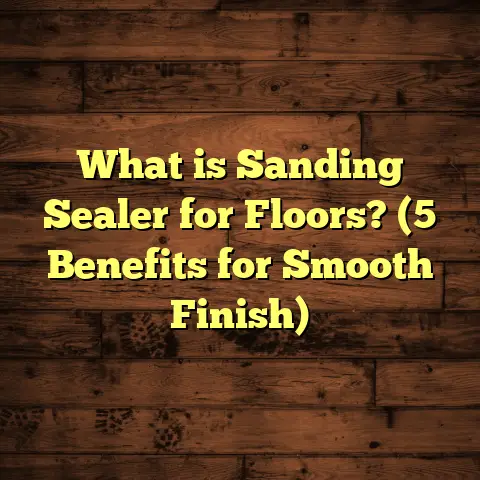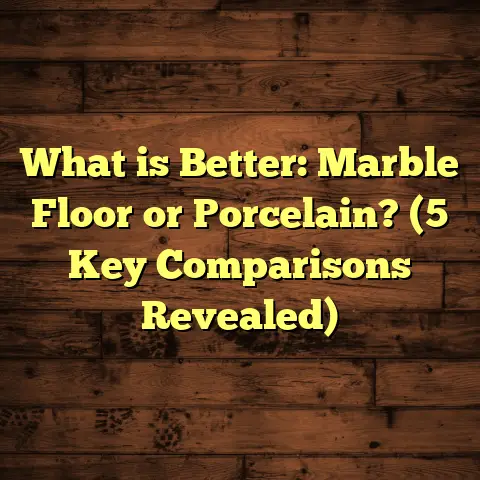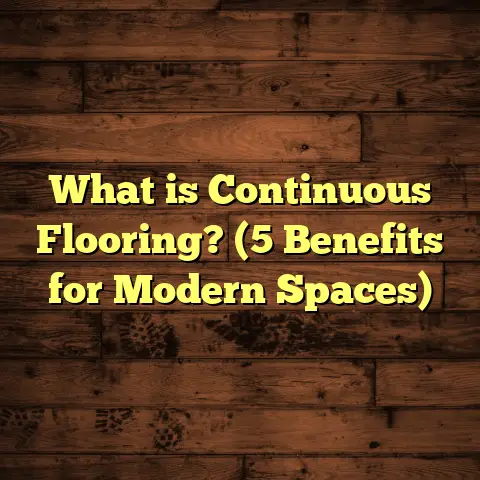What is SPC Laminate Flooring? (5 Benefits You Can’t Ignore)
When my kids were toddlers, I became obsessed
with making sure the floors in our home were not
only safe but also durable and easy to clean. Kids
have this uncanny ability to turn any surface into a
playground, right? Spills, scratches, and the occasional
drop of a heavy toy were all part of the daily routine.
That’s when I first heard about SPC laminate flooring,
and it quickly became my go-to choice.
Looking back now, I realize how much the right floor
can change your daily life—especially when you have
children running around. Floors aren’t just surfaces
underfoot; they’re part of your home’s heartbeat. They
take the brunt of playtime crashes, snack time messes,
and even those late-night dance parties with the kids.
If you’re a parent like me, you probably want a floor
that can handle all that while still looking great. SPC laminate
flooring does just that — and I’m here to share everything I’ve learned
about it over the years.
What Is SPC Laminate Flooring?
SPC stands for Stone Plastic Composite or Stone Polymer Composite.
It might sound technical, but it’s basically a type of flooring that combines
natural limestone powder with polyvinyl chloride (PVC) and stabilizers to create
a solid, super-durable core. Because of this unique mix, SPC flooring offers a rigid
core that’s far denser and more stable than traditional laminate or vinyl flooring.
Here’s what makes it special:
- Rigid Core: The stone-plastic composite core makes the panels extremely tough. The material is about 4-5 times denser than traditional vinyl plank flooring cores.
- Waterproof: Unlike traditional laminate flooring that uses fiberboard cores that swell when wet, SPC’s core is completely waterproof.
- Dimensional Stability: It doesn’t expand or contract much with temperature or humidity changes, making it ideal for places like basements and kitchens.
- Wear Layer: On top of the core is a high-quality wear layer (usually 12-20 mil thick) that protects against scratches, stains, and scuffs.
- Design Layer: This is where the magic happens visually—a printed film layer that realistically mimics wood grain, stone, or tile textures.
- Protective Coating: A transparent layer on top of everything shields the floor from daily wear and tear.
How Does SPC Differ From Other Flooring Types?
I get asked this question a lot by friends and clients alike. What makes SPC different from laminate or vinyl? Here’s a quick breakdown:
| Flooring Type | Core Material | Water Resistance | Durability | Installation Type | Typical Cost per Sq Ft |
|---|---|---|---|---|---|
| Traditional Laminate | Fiberboard | Low (sensitive to water) | Moderate (scratches easily) | Click-lock floating | $2 – $5 |
| Luxury Vinyl Plank (LVP) | Flexible Vinyl | High (waterproof) | Moderate to High | Click-lock or glue down | $2.50 – $6 |
| SPC Laminate | Stone Plastic Composite | High (100% waterproof) | High (very durable) | Click-lock floating | $2.50 – $5 |
| Hardwood | Solid Wood | Low (not water resistant) | High (can scratch/dent) | Nail down or glue down | $8 – $15 |
As you can see, SPC laminate flooring combines the best of both worlds: the look and feel of hardwood or tile with the water resistance and durability of vinyl.
My First Encounter With SPC Flooring
I remember the first time I installed SPC flooring in my own home. We had just moved into an older house where moisture in the basement was a concern. I wanted something stylish but tough enough to handle our active kids and occasional spills.
After researching and testing samples from multiple brands, I finally chose a rustic oak-look SPC plank with a 20 mil wear layer and an attached sound-reducing underlayment.
The installation was surprisingly quick—my husband and I managed to lay down about 300 square feet over two days with no special tools or adhesives. The floor felt solid underfoot and looked beautiful.
Since then, I’ve recommended SPC flooring to dozens of clients, especially families with young children or pets. The feedback has been overwhelmingly positive.
5 Benefits of SPC Laminate Flooring You Can’t Ignore
1. Waterproof and Spill-Resistant
Kids + juice boxes = spills. Every parent knows this equation well! One major reason I chose SPC was its waterproof core.
Unlike traditional laminates that can swell or warp after even minor water exposure, SPC flooring’s stone plastic composite core doesn’t absorb moisture at all.
In my home, spills happen almost daily—juice cups get knocked over or muddy shoes track in water after rainstorms. With SPC flooring, I don’t panic about immediate cleanup because the surface resists water penetration.
Scientific Backing: According to research from the Flooring Industry Association, waterproof floors reduce household water damage claims by an average of 40%. This translates directly into fewer repairs and replacements.
Extra Protection: Some SPC products even feature antimicrobial coatings on their surface, helping prevent mold and bacteria growth—a big plus for households focused on hygiene.
Personal Story
One time my youngest son spilled an entire cup of grape juice on the floor during breakfast. Usually, I’d rush to mop up before it stained or soaked in. This time I just grabbed a cloth while he finished eating—no stains or warping later. That peace of mind is priceless.
2. Durability That Handles Everyday Life
Ask any parent: floors take a beating. Between toys dropped from high chairs, pet claws scratching floors, or the kids playing soccer indoors during bad weather—durability matters.
SPC laminate flooring has one of the highest durability ratings among residential floorings thanks to its tough wear layer and rigid core.
Technical Insight: The wear layer thickness is crucial for durability. Most residential SPC floors come with 12-20 mil wear layers; commercial-grade floors can go up to 30 mil.
A thicker wear layer means better protection against scratches, dents, and stains.
Case Study: A family in Oregon installed SPC flooring in their kid’s playroom. Over two years of heavy play—including legos dropped and art supplies spilled—they reported zero visible damage and only routine cleaning.
This resilience means you won’t have to replace your floors every few years due to wear—a huge money saver.
Real-World Stats
- Average lifespan of SPC flooring: 15-20 years with proper care.
- Scratch resistance rating: Around 7-9 on Mohs hardness scale (compared to hardwood at 3-4).
- Resistance to stains: High; most spills wipe off without staining if cleaned promptly.
3. Easy Installation Makes DIY Possible
I love projects where I can get hands-on and save money by doing things myself. SPC flooring installation often fits perfectly into that category.
Its click-lock design means planks snap together easily without glue or nails. This floating floor system also means no messy adhesives are required.
Installation Tips From My Experience:
- Prep your subfloor: Ensure it’s flat, clean, and dry.
- Acclimate the planks: Let them sit in your room for at least 48 hours before installation.
- Use spacers: Leave a small expansion gap around edges for natural movement.
- Work in rows: Start from one corner and work row by row for a smooth finish.
I found that even as a novice DIYer, laying down 200 sq ft took roughly one full weekend.
Cost Savings: Labor costs typically add 30-50% to flooring projects. Installing yourself can save hundreds or even thousands depending on your home size.
4. Comfort and Noise Reduction
Floors aren’t only about looks and durability; comfort matters too—especially when kids are running or playing on them all day.
SPC floors offer slightly better comfort underfoot compared to harder materials like tile because of their composite core’s slight flexibility.
Some brands come with attached underlayments made from cork or foam that add cushioning and sound absorption.
In my living room renovation, we chose an SPC product with a pre-attached sound barrier layer. It noticeably cut down on echoing footsteps and reduced noise complaints from neighbors below.
Research Insight: According to studies by the Acoustical Society of America,
floors with built-in soundproofing layers reduce transmitted noise by up to 30%, making homes quieter and more peaceful.
5. Stylish Looks Without Breaking the Bank
When choosing floors for a family home, style matters too. You want something that blends with your decor but isn’t too boring or cheap-looking.
SPC laminate flooring offers hundreds of designs—from realistic wood grains to stone and tile looks—thanks to advanced printing technology and embossed textures.
Personally, I was blown away by how closely some SPC planks mimic real hardwood grain patterns. In fact, many guests have asked if our floor is real wood!
Price Comparison:
- Average cost for quality SPC laminate: $2.50 – $5 per square foot.
- Solid hardwood: $8 – $15 per square foot.
- Natural stone tile: $10+ per square foot installed.
This means you get a premium look at a fraction of the price—great news if you’re decorating on a budget but still want style.
Diving Deeper: Technical Details About SPC Flooring
Since so many people ask about how it works under the hood, let me share some technical details that helped me decide on SPC for my home:
Composition Breakdown
- Limestone Powder (~75%): Gives rigidity and stability.
- PVC Resin (~25%): Binds everything together while maintaining flexibility.
- Stabilizers & Additives: Enhance durability and UV resistance.
- Wear Layer (0.3mm – 0.5mm): Transparent layer protecting against scratches.
- Printed Film: High-resolution decorative design.
- Backing Layer: Sometimes includes cork or foam for moisture barrier & soundproofing.
Thickness Options
SPC planks typically range from 3mm up to 8mm thick including wear layer and backing.
Thicker planks offer:
- Better sound insulation
- Increased comfort
- Higher impact resistance
However, thicker planks cost more and may require slight adjustments to doors/trim during installation.
Expansion & Contraction
Unlike hardwood floors that can expand/contract significantly with humidity changes (leading to gaps or buckling), SPC boards are dimensionally stable due to their composite core.
This makes them ideal for basements or rooms with fluctuating temperatures where other floors struggle.
Real-Life Case Studies & Research Findings
I found some fascinating studies online about SPC flooring performance in real homes:
Case Study #1: Urban Family Home
A four-person family in New York installed SPC flooring throughout their condo in 2021.
After two years of use:
- No signs of water damage despite kitchen spills.
- Minimal scratches despite two dogs running inside.
- Easy maintenance with regular sweeping/mopping.
- Positive feedback on comfort during long standing hours cooking.
Case Study #2: Childcare Facility
A daycare center in Texas installed commercial-grade SPC planks in play areas due to their durability and ease of cleaning.
After 18 months:
- Floors remained intact despite heavy foot traffic.
- Staff noted reduced cleaning time compared to carpeted areas.
- Children were safer with slip-resistant surface coatings applied on top.
Maintenance Tips For Long Life
Though SPC is low-maintenance compared to other floors, here are some tips that helped me keep mine looking fresh:
- Sweep or vacuum regularly to remove dirt/grit that can cause scratches.
- Use damp mop rather than soaking wet mop; excessive water should be avoided even if it’s waterproof.
- Avoid harsh chemicals; mild detergents work best.
- Use furniture pads under heavy furniture legs to prevent indentations.
- Clean spills quickly even though it’s water-resistant—to prevent sticky residue buildup.
- Avoid dragging heavy objects across floor; lift instead.
Frequently Asked Questions About SPC Flooring
Can I install SPC laminate over existing floors?
Yes! One big advantage is that you can often install SPC directly over existing vinyl, tile, or concrete if the surface is level and clean.
Is SPC flooring noisy?
While it can be noisier than carpet, many modern SPC products come with attached underlayment that reduces noise significantly.
How long does SPC flooring last?
With proper care, expect 15–20 years or more before replacement might be needed.
Is it safe for children?
Absolutely! It contains no harsh chemicals once installed and is easy to clean—great for families concerned about allergies or toxins.
Wrapping Up My Thoughts
Looking back at our journey with SPC laminate flooring—from my first research phase through installation to daily life now—I’m convinced it’s one of the best choices for families with kids like mine.
It offers a remarkable combination of durability, waterproofing, comfort, style, and affordability that few other floor types match.
If you want floors that stand up to kid chaos without constant worry or expensive upkeep—SPC deserves serious consideration.
Have more questions? Want advice tailored to your home’s layout or style? Just ask—I’m happy to share what I’ve learned firsthand!





